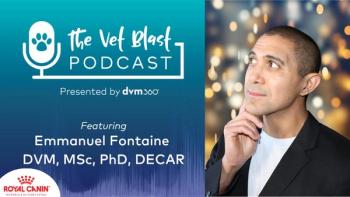
- dvm360 November 2023
- Volume 54
- Issue 11
- Pages: 56
Shocked? Extracorporeal shockwave therapy offers many benefits
How shockwave therapy works, including applications, considerations, and benefits
This content is sponsored by Zomedica.
Extracorporeal shockwave therapy (ECSWT) has been around for
a while, but it wasn’t until the past few decades that the medical world—specifically the veterinary industry—began realizing its full potential for treating soft-tissue injuries. To delve deeper into this topic, Leilani Alvarez, DVM, DACVSMR, CVA, CCRT, joined Adam Christman, DVM, MBA, on a recent episode of dvm360 Vet Perspectives to give an overview of ECSWT by introducing PulseVet® Shock Wave technology.
How it works
A trode is attached to a cable and can be operated via the machine’s touch screen to deliver the therapy. “Basically, a spark goes off in [the trode] and [the soft top] has a fluid medium in it. When the spark plug goes off in [the trode’s top], it sets off little bubbles that then get dispersed as sound waves that come across...into the tissue,” Alvarez said. “It’s high pressure, high velocity, but relatively low frequency.”
The subsequent decrease in pressure after the bubbles burst causes a cavitation. In muscles, this creates cellular permeability and increases blood flow, promoting anti-inflammatory healing. “You also get a pretty massive endorphin release. Those are the body’s natural painkillers,” Alvarez said.
Applications, conditions, and patient consideration
Shockwave therapy, specifically electrohydraulic shockwave therapy, is notably effective in treating chronic, repetitive conditions that do not respond to surgery, such as arthritis. Conditions like arthritis and lumbosacral disease are common in the veterinary clinic, so it’s fortunate that using ECSWT to treat a patient requires few considerations.
When this technology was first introduced, patients needed to be sedated due to the high pressure and high velocity of the shockwaves. Enter PulseVet’s newest probe: X-Trode. Although the same amount of energy is provided, X-Trode’s wider dispersion of pressure helps patients remain more comfortable during treatment and, consequently, not require sedation.
“It feels so good because [patients] get that endorphin release. I actually find that patients relax during the treatment,” Alvarez said. Although ECSWT doesn’t cause excess pain or require sedation, dogs can become anxious when entering the clinical setting or hearing the machine produce loud noise.
“Feed them treats because you don’t need to sedate them,” Alvarez said. Even the presence of the pet parent can be enough to ease the dog’s worry. It helps that ECSWT can produce positive results within just a few sessions. Most patients being treated with shockwave therapy only require 2 to 3 treatments that are 2 to 3 weeks apart before achieving results.
Contraindications and adverse effects
Contraindications
ECSWT is relatively safe, so there are only a few things for practitioners and pet parents to keep in mind. Because the technology employs bursting bubbles to produce the shockwaves, it is crucial that the treatment is not applied near large vessels or the lungs. “If we introduce these bubbles that then collapse in the lungs, we potentially have a pneumothorax,” Alvarez said. Additionally, because shockwave therapy brings a lot of blood flow to the area being treated, it’s good practice to avoid tumors or the uterus of pregnant patients.
Adverse effects
Although there are a few contraindications to keep in mind regarding ECSWT, adverse effects are minimal. Petechiae and bruising can result from the therapy but usually subside within 48 hours and have no long-term effects on the patient.
Shockwave vs laser therapy
“I think laser [therapy] is used for everything and, [although] I think it has some really excellent applications, it’s not the panacea,” Alvarez said. Although both shockwave and laser therapy are anti-inflammatory, increase blood flow, and are known to aid in pain relief, Alvarez said ECSWT creates “a much bigger change at a cellular level.” The 2 modalities are different in nature; shockwave employs sound waves and is an acoustic therapy, whereas laser is a photobiomodulation therapy or light therapy.
Although laser therapy is a great therapeutic resource, it is a less powerful treatment and may require more sessions. ECSWT is best used to treat chronic, persistent injuries. “It is really good when you have tissues that are not likely to heal on their own,” Alvarez said.
Articles in this issue
almost 2 years ago
Holiday gift ideas for pets and professionalsalmost 2 years ago
Enrichment never gets old: Why senior pets need stimulation tooalmost 2 years ago
How to leverage allyship to create more inclusive culturesalmost 2 years ago
Is your practice seeing enough senior pets?almost 2 years ago
The spectrum of care with Emily M. Tincher, DVMalmost 2 years ago
Hire attitude and gratitude...train aptitude!almost 2 years ago
Nonpharmacologic management of canine osteoarthritis: Part 1almost 2 years ago
Kick off 2024 with a Fetch dvm360® conference in CharlotteNewsletter
From exam room tips to practice management insights, get trusted veterinary news delivered straight to your inbox—subscribe to dvm360.






